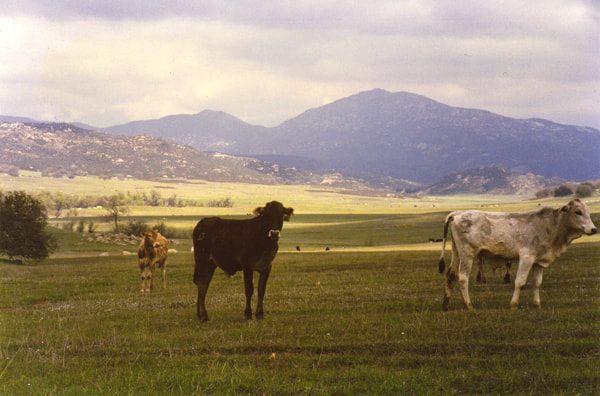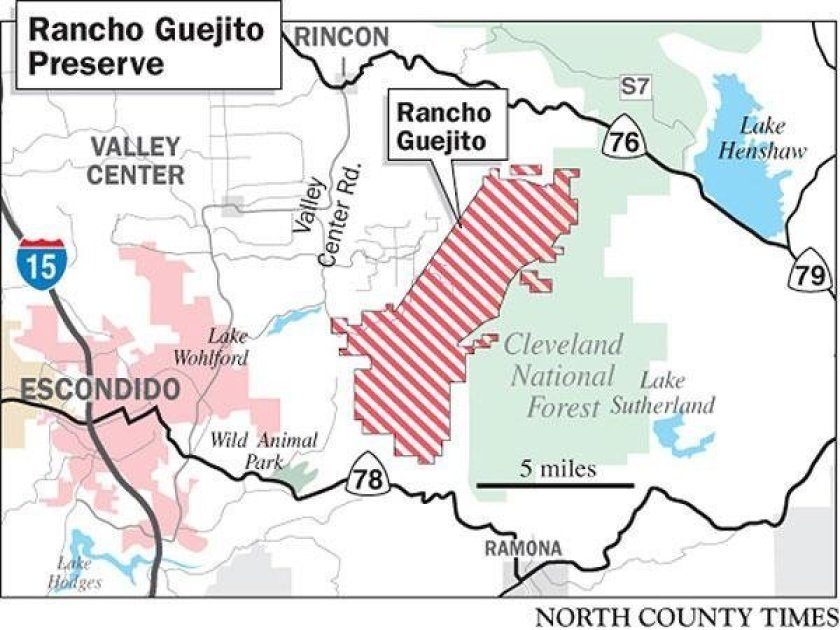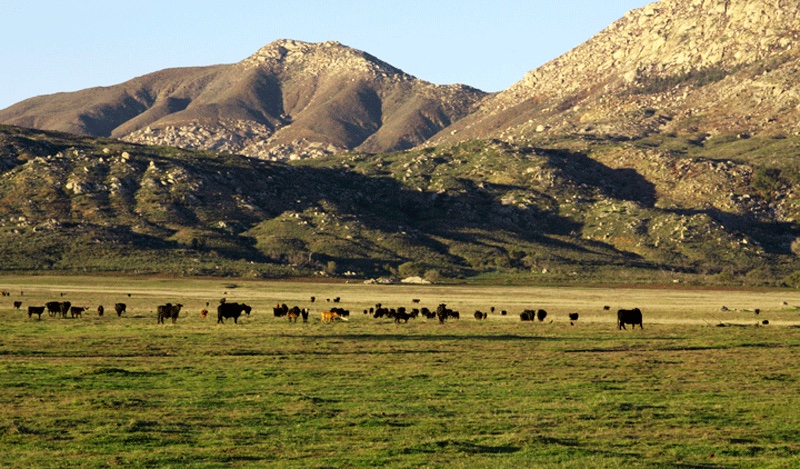This presentation of Treehuggers International originally aired on Oct. 19, 2008, on KBZT FM 94/9.
Thanks to Dr. Dan Silver from the Endangered Habitats League, and Bruce Coons from the Save Our Heritage Organisation who first visited Rancho Guejito as part of a research trip in 1969 and took the footer photo at the bottom of this post, for joining us for this Treehuggers International discussion on Rancho Guejito, often referred to as the “jewel of San Diego conservation.”
A relic of the Mexican land grant system, Rancho Guejito is the largest area of privately-owned, undeveloped land in Southern California, and it’s earned something of a mythical reputation as a place that many in the Southern California conservation community have heard about, but few have visited. Rancho Guejito has survived undeveloped for the past 200 years, in part, because of its remote location and a legacy of determined stewardship that, until recently, the ranch’s succession of owners have exercised.
Located east of Valley Center and Lake Wohlford and north of the San Diego Zoo’s Wild Animal Park near the La Jolla Indian Reservation, Rancho Guejito is made up of some 21,000 acres, or 36 square miles. From the end of the Spanish colonial period to the 21st century those fortunate enough to visit are consistent in their ecstatic descriptions of the the valley’s wild, isolated qualities. Early in the 1970s plans were developed for Rancho Guejito to be set aside as a California State Park, but due to funding dilemmas between the Reagan and Brown administrations, this never came to pass.
Golden eagles and mountain lions make this huge expanse of land their home, and as one of the rare, intact habitats in Southern California, Rancho Guejito continues to function as a vital wildlife corridor. Unfortunately, like the recently piecemealed Tejon Ranch in northern Los Angeles County and Kern County, the fate of Rancho Guejito may soon be in the hands of real estate speculators, upzoners, and developers, and further dissection of the area’s habitat may not be far off. If that were to occur, it would be tragic.
After years of publicly stating their desire to keep the valley’s wild character intact, the family that owns Rancho Guejito recently made an about-face. The newly-christened Rancho Geujito Planning Group has proposed a development plan for all 22,000 acres of the ranch, including the construction of 10,000 homes. Because more sprawl is always the answer.
We at Treehuggers International are opposed to this and all environmentally-damaging, unsustainable projects. With the nearby Merriam Mountains proposal in Hidden Meadows appearing to be a done deal, and in the wake of the crash in housing prices and calamitous overdevelopment of Chula Vista, San Marcos, Vista, and Inland Empire areas from Temecula to Banning, one wonders how any kind of development at Rancho Guejito is necessary or responsible. Any housing built there will certainly be anything but “affordable.”
Water issues come to mind too. At a time when farmers in Escondido, Valley Center, and Pauma Valley have been forced to decapitate entire groves of avocado trees due to water shortages, what kind of message does it send to build to 10,000 mcmansions nearby? Especially when little to no housing for people who work for a living without six-figure salaries is available anywhere in the county. It would seem developers are still enjoying free rein in San Diego County despite mandatory water cutbacks and limited access to a potential development site – which has burned again and again in regular wildfire intervals.

2010 Addendum: Rancho Guejito Planning Group Meeting
On Feb. 2nd, 2010, one year and four months after this show first aired, the Rancho Guejito Planning Group held an informational meeting in Pauma Valley that was, according to one person there, short on new information. Our friend Rick Halsey with the California Chaparral Institute was in attendance with several reporters, including J. Harry Jones from the San Diego Union-Tribune, Native American community representatives, and area residents.
According to Rick, question after question resulted in few concrete answers. Inquiries about wildlife corridors, water and sewage services, and infrastructure plans in and out of the development other than Highway 78, which is the only major access in road in the area, were “stonewalled,” said Rick, while Indigenous concerns were given especially short thrift.
“A representative of the Pauma Indian band reminded the spokesperson about the importance of cultural issues and that Indian bands want to be involved,” said Rick. “At this point the spokesperson appeared to be getting tired responding and saying nothing, so she didn’t say much more than ‘I don’t know from here on out.’ She was especially silent whenever a Native American spoke.”
When another Indigenous representative “explained the importance of the spiritual connectedness local Indian bands have with the land, especially land that hasn’t been destroyed yet by development, the spokesperson said nothing of consequence.” When asked about environmental impact studies (EIS), the spokesperson “talked about their maps of the area, which were essentially topographical and vegetation maps any citizen can request from the county. When asked about rare stands of Engelman Oaks on the property, rapidly vanishing from Southern California, the spokesperson agreed they were ‘important,’ but failed to explain what plans were on the table to preserve them once development commences.”
At some point the Union-Tribine’s J. Harry Jones pressed the spokesperson on why the owners of Rancho Guejito had decided to consider developing the area after decades of resistance. According to Rick the spokesperson claimed ignorance, and explained the “family’s previous conservation commitments were made before she became involved with the project.” Another representative of the Rancho Guejito Planning Group denied they had been approached by environmental groups about how to potentially manage the site without development.
Rick later asked whether the owners had done any environmental studies or reports concerning the property. The spokesperson replied they had vegetation maps and topographic maps. Rick followed up and asked if the owners had ever drilled wells or examined the water resources on the property. According to Rick, “the spokesperson said she didn’t know.”
“I asked if she could give us two things,” he said. “One, a timeline when she would be able to come back and actually provide us with useful information, and two, a commitment to bring in the local Native American bands in as part of the process.” According to Rick, “the spokesperson mumbled on about this being a ‘complicated process,’ and then I asked my second request again. No commitment on anything.”
 More about this story at
More about this story at
- Brief History of Rancho Guejito, Save Our Heritage Organisation
- Waheto National Park, California Chaparral Institute proposal
- Guejito: California’s Last Rancho, Valley Center Historical Society
- Multiple Species Conservation Program North County Plan, San Diego County
- Rancho Guejito Matriarch Nancy Coates Dies at 94 (Valley Roadrunner, April 1, 2015)
- Rancho Guejito A National Park? We Aren’t Selling (San Diego Union-Tribune, Oct. 23, 2013)
- Owners of Rancho Guejito Hit With More Fines (San Diego Union-Tribune, Sept. 29, 2012)
- County Won’t Drop Restoration Demands (San Diego Union-Tribune, July 31, 2012)
- Illegal Road at Rancho Guejito Leads to Fines (San Diego Union-Tribune, April 6, 2012)
- County Orders Rancho Guejito to Restore Canyon (North County Times, Feb. 5, 2012)
- Rancho Guejito Future Is Hot Topic (San Diego Union-Tribune, Feb. 4, 2010)
- Rancho Guejito Owner In Talks to Open Land to Public (North County Times, Nov. 8, 2009)
- Rancho’s Future: 10,000 Houses? (San Diego Union-Tribune, Oct. 28, 2009)
- Supervisor Seeks Federal Help to Buy Rancho Guejito (North County Times, May 6, 2008)
- Horn Aims to Preserve Sprawling Geujito Ranch (North County Times, March 24, 2008)
- Rancho Guejito Is Every San Diegan’s Legacy (North County Times, March 2, 2008)
- Pristine Ranch Is A Saga of Money, Intentions (North County Times, March 2, 2008)
- A Plot Both Wide and Thick (Los Angeles Times, May 24, 2007)
- Rancho Guejito (Los Angeles Times, May 24, 2007)
- Rancho Guejito: A San Diego County Legacy (San Diego Union-Tribune, Jan. 21, 2007)
- Guejito Owners Explore Escondido Annexation (North County Times, Jan. 13, 2007)
- Dallas Man Seeks Control of North County Ranch (North County Times, Oct. 27, 2006)
- Save Rancho Guejito
- Friends of Hellhole Canyon
Rancho Guejito footer photo © 1969 Bruce Coons, all rights reserved.
North County Times Rancho Guejito map © 2009 San Diego Union-Tribune.
We are seeking a photo credit for the banner image of cattle in Rincon Valley.

